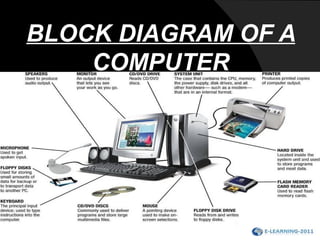
Block diagram of a computer
- 1. BLOCK DIAGRAM OF A COMPUTER
- 2. BLOCK DIAGRAM OF COMPUTER
- 3. INPUT UNIT Computer receives data and instructions through the Input Unit. The input unit consists of one or more input devices. Input devices include: Keyboard Mouse Joystick Scanner
- 4. FUNCTIONS OF INPUT UNIT Accept the data and instructions from the outside world. Convert it to a form that the computer can understand. Supply the converted data to the computer system for further processing.
- 5. OUTPUT UNIT Computer provides information and results of computation to the outside world through the Output Unit The output unit consists of one or more output devices. Output devices include: Monitors Printers Speakers
- 6. FUNCTIONS OF OUTPUT UNIT Accept the results produced by the computer. (These are in a coded form.) Convert it to a form that the outside world can understand. (OR, Converts it into human readable form.) Supply the converted results to the outside world.
- 7. CENTRAL PROCESSING UNIT It is the brain of the computer. The ALU and the Control Unit (CU) of a computer system are jointly known as the central processing unit. CPU performs actual processing of data, according to instructions from programs.
- 8. FUNCTIONS OF CPU It performs all calculations. It takes all decisions. It controls all units of the computer.
- 10. CONTROL UNIT It controls all other units in the computer. It is the central nervous system of the computer that controls and synchronizes its working. FUNCTIONS OF CONTROL UNIT It instructs the input unit, where to store the data after receiving it from the user. It controls the flow of data and instructions from the storage unit to ALU.
- 11. ARITHMETIC LOGIC UNIT All calculations are performed in the Arithmetic Logic Unit (ALU) of the computer. FUNCTIONS OF ALU It performs all arithmetic operations (addition, subtraction, multiplication, and division). It performs all logic operations. It does comparison and takes decision.
- 12. STORAGE UNIT The storage unit of the computer holds data and instructions that are entered through the input unit, before they are processed. Storage devices are divided into two categories: Primary Memory or Main Memory Secondary Memory
- 13. FUNCTIONS OF STORAGE UNIT It received the data and instructions required for processing from the input unit. It stores the intermediate results.• It stores the final results before these results are released to the output unit. It saves data for later use.
- 14. THANK YOU